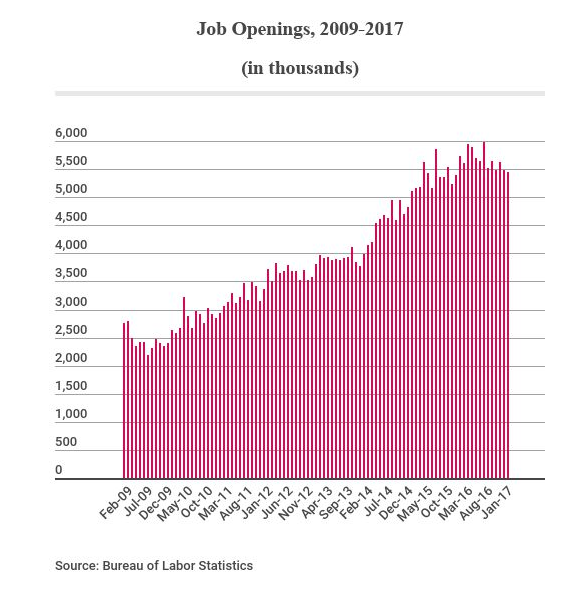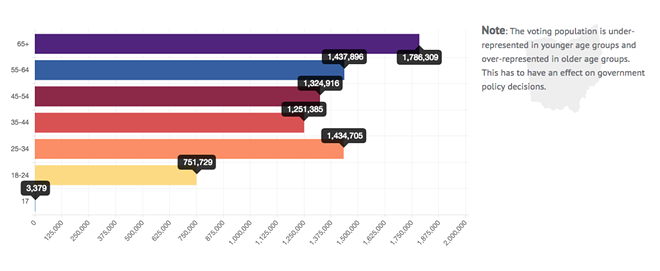When former president Barack Obama won the state of Ohio in the electoral college, he did so by earning 23 percent more votes than Mitt Romney in 2012. However, just four years later, the current sitting president Donald Trump won the state by six points.
The New York Times published an analysis of the state today, trying to figure out what the 2016 election and Ohio's reputation as a "purple state" would mean for the 2018 midterm election, the gubernatorial race in particular. In 2016, many working-class democrats flipped parties to vote for Trump, a candidate who promised to add jobs that would benefit average, working-class Americans.
In Ohio, Trump said employers “weren’t hiring for years and years and years,” when in fact, the unemployment rate was 4.8 percent when he took office — close to what economists consider “full employment.” He also said during his visit back in May that “all of a sudden, we have jobs,” even though the number of job openings has been steadily increasing since mid-2009.
There has been a 20 percent increase since he's taken office, but as Fact Check stated on inauguration day, "Trump won the election while claiming 'our country is stagnant,' even though he inherited an economy that was experiencing steady if unspectacular growth in output, jobs and incomes.” The reality of the situation is that the job market was on the rise before Trump even took office.
It's no surprise that Trump won Ohio on his platform of adding more working-class means of employment, because the average Ohio voter (and citizen) is older, whiter and less likely to be college educated than the rest of the country, according to state statistics. This demographic is representative of those who are employed working with steel or coal, both dying industries Trump claimed he would bring back to life.
Ohio Voter Project, an organization that documents as much information on Ohio Voters as possible, recently updated their database to show that the voter registration population is over-represented by older age groups, and under-represented by younger age groups. A shame, considering the younger age groups are the ones that will feel a longer impact on voting decisions made by the older generations.
An estimated 7,990,319 people are registered to vote in the state of Ohio, but only 751,729 of those people are between the ages of 18-24 compared to the 3,224,205 from voters that are age-eligible to receive senior citizen discounts at restaurants (55+).
What is interesting, however, is that Ohio Voter project also reports that over twice as many registered voters with established party affiliations in Ohio are registered as non-affiliated. There are more republicans registered than democrats, but non-affiliated registrations completely eclipse both parties.
According to state statistics, the state is 81.6 percent white and only 27.5 percent of citizens have completed some form of higher education. As is well-known, the major reason that Ohio tends to be a swing-state, rather than a guaranteed blue or red state, is the liberal pockets in and around Ohio's major cities. Why do these pockets exist in the first place?
Population diversity.
Cuyahoga County, Franklin County and Hamilton County (representing Cleveland, Columbus and Cincinnati, respectively) are the three most populated cities in the state, and are also the homes of the most diverse populations. Diverse populations equate to more liberal and progressive voters, even in deep red states.
On the high end, 40 percent of Cuyahoga County residents are part of a minority group. Comparatively, Holmes County, which serves as the home to the second largest Amish community in the country, is 98 percent white. Despite Cuyahoga County being the most diverse county in the state, it remains one of the most segregated. Warrensville Heights has a population that is made up of 95.5 percent of minority citizens, while Independence is 96.1 percent white.
Last year, in the November general election, only 273,383 of Cuyahoga County's 883,890 registered voters went to the polls. Meaning nearly 70 percent of registered voters in the most diverse county in the state didn't vote.
The same happened in Franklin County, where only 23.72 percent of registered voters showed up, and Hamilton County boasted similar numbers to Cuyahoga with 31.22 percent.
So what does this mean in terms of voting? It means that statistically, older white people with only a high school diploma make election decisions that impact the rest of the population, often times, parts of the population they will never interact with.
Getting to the polls is not always an easy thing for people, due to limitations with employment, transportation, child-care and access to registration in the first place. Fortunately, there have been a variety of efforts this year to help get people to the polls. Lyft is offering free and discounted rides to the polls, UHBikes is offering free rides to anyone choosing to vote early.
If citizens want change is to occur, it will only be done with voting power. Statistically speaking, the "average Ohio voter" demographic is going to turn out to the polls regardless if progressives do or not.




